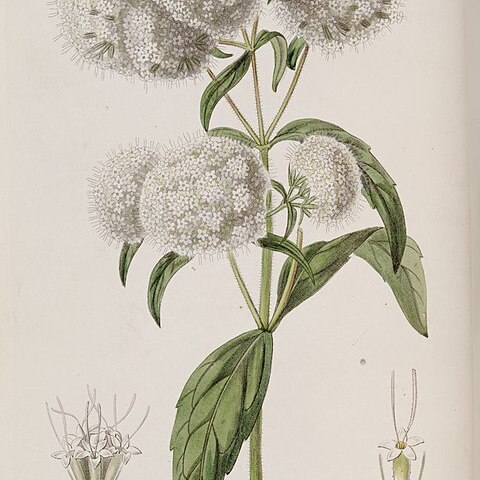Sparingly branched rhizomatous perennial herbs; stems often brownish or purple, terete, slightly striate, densely puberulous. Leaves opposite; blades ovate to oblong-elliptical, 3-9 cm long and 1.5-5.0 cm wide, the base cuneate and decurrent onto petiole, the margins entire to serrate, the apex obtusely to sharply acute, the surfaces glandular punctate, the upper surface glabrate to sparsely puberulous, the lower surface puberulous on veins, glabrous or scarcely puberulous on areoles, the veins distinctly trinervate from near base; petioles 2-25 mm long, winged and often distally indistinct from lamina. Inflorescence usually flat-topped and densely corymbose, the primary branches opposite, usually spreading at less than 450, the branching sometimes diffuse, the branches densely puberulous to subtomentose, the ultimate branches 0-2 mm long, rarely to 8 mm long. Heads 6-8 mm high; involucral bracts narrowly oblong, mostly 4-5 mm long and 0.7-1.0 mm wide, glandular punctate, distinctly puberulous, the apex often short-acute or prominently scarious; corolla white or rarely slightly pink, 4.5-5.5 mm long, glandular punctate, with short hairs on tubes and few on limb, the lobes equal, 0.7-1.2 mm long with many multiseptate hairs on outer surface. Achenes ca. 3 mm long, sparsely short-hispid; pappus with a crown of separate to united scales ca. 0.3-1.0 mm high, subentire to dentate, with 0-4 barbellate, basally winged awns ca. 4 mm long, often alternating with scales.
More
Straggling to erect perennial herb or subshrub (sometimes shrub-like) to 160 cm high, with a large tap root. Leaves usually opposite, sometimes alternate; lamina ovate to lanceolate, 3–6 cm long, ± acute apex, serrated or toothed margin, 3-veined from base, aromatic when crushed, hairy; petiole to 1 cm long. Flowers small, white or pale pink, in clusters at ends of branches and often combine at the apex to form dense umbel-like heads. Adapted from Queensland Government (2016). Detailed Flora description pending.

